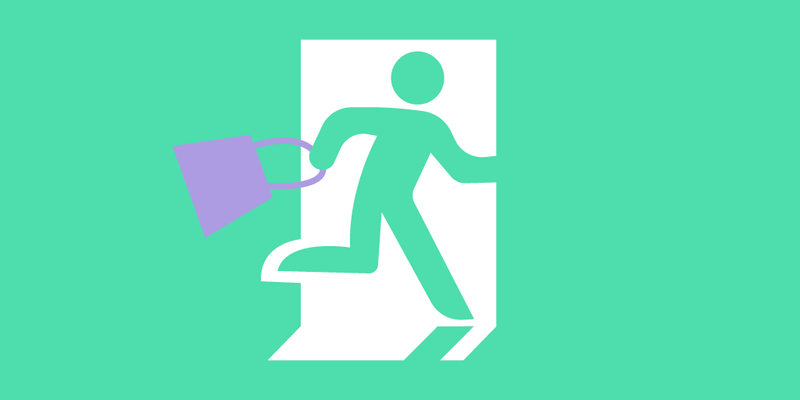If there is one word that sums up every retail business owner's nightmare, it’s churn.
Customers are fickle creatures. They're easy to lose, hard to win over, and often you don't even know what's on their mind.
In fact, out of 26 unhappy customers, only one complains, and the rest churn.
If you work in retail, you’ve probably asked yourself these agonizing questions:
Why are my customers leaving for my competitors?
What am I doing wrong?
How can I improve my level of service and get my customers back?
To help you understand how to retain customers, we’ve come up with 5 reasons why your customers leave.
Let’s dive right in.
1. Playing favorites makes your customers leave
One of the most difficult things to do as a business is to measure the value of a customer.
If you offer tons of discounts and offers to customers who are just looking to redeem them and leave, that’s a waste of not only resources but time.
On the other hand, it’s worth offering every incentive possible to a customer who’s potentially willing to spend hundreds of dollars.
The only way to resolve this catch-22 situation is by focusing on customer service.
For 84% of consumers, lack of information from a salesperson is a cause of frustration. Failing to answer their questions, you risk losing at least 60% of all customers, who don’t tolerate the indifference.
Remember: It takes 12 positive customer service experiences to make up for one negative experience. And one poor service experience is enough for 58% of customers to stop purchasing the services of a company.
The solution is simple — start treating all customers equally. Instead of rewarding expected behavior, you should focus on the actual behavior.
Many companies nowadays, including credit card companies and airlines, offer reward points and loyalty programs.
This way, the customers who actually spend the most get rewarded for their behavior.
2. Lack of convenience impedes client retention

In our digital world, it’s not enough to sell your customers a product or service. You have to sell them convenience as well.
Ever since Jeff Bezos started Amazon over two decades ago, it was clear that the way to succeed as a business is to invest in amazing customer experience.
Retail businesses have to account for never-before-seen standards of convenience. Good old-fashioned brick-and-mortar stores are now competing with a “one-click” shopping experience.
Every innovative company is experimenting with a mixed experience — the combination of the digital and real world.
Augmented reality apps from Google will soon let you point your smartphone at a restaurant to its Yelp reviews. Fashion stores are investing in interactive digital experiences instead of changing rooms.
And finally, Amazon has done away with checkout counters altogether — you can pick up your groceries from a store and walk out, with zero interaction needed.
In short, you have to do everything in your power to make the buyer’s journey as streamlined as possible. Otherwise, you’re going to suffer the negative effects of poor customer service.
Identify the stage at which you’re losing your most customers, and take the appropriate action required to minimize drop-offs.
The most successful businesses nowadays are ones which successfully marry the physical and virtual components of the shopping experience.
3. Long wait times cause customer walkouts

Don’t let the dawn of the virtual reality age distract you from the basics. If you’re in retail, you’re still likely to have checkout counters in some shape or form.
And where there are checkout counters, there’s a risk of long queues and high wait times — the ultimate villains in retail.
86% of customers will abandon a store if queues are too long.
For most customers, a waiting line that is seven people deep is no different than a waiting line seven hundred people deep.
There are a lot of questions you can ask yourself, but the most prominent is this: Have you implemented a retail queue management system in your retail business?
Chances are, you haven’t. Probably because you don’t think your queuing situation warrants a closer look.
But the importance of automated queue management cannot be overstated, especially in the context of customer service.
Disorganized queues and long wait times stand in a way of retaining customers. Failing to reduce customer wait time also loses your workers countless hours they could’ve used more efficiently.
Getting a customer to your checkout counter is already half a battle won. The real challenge, of turning them into a loyal and returning customer, begins then.
With a waiting line management system like Qminder, the whole experience is specifically designed to help you smoothen out the rough patches in queuing.
4. Lack of innovation is a major reason customers leave
Although expect a consistent experience, there is a difference between consistency and lack of innovation.
When all you end up offering your visitors is “same old, same old”, you risk scaring them away. The thing your business — or anyone else’s, for that matter — needs is innovation.
Innovation isn’t something you can set and forget. It requires close attention and constant maintenance.
The very nature of retail today makes innovation a necessary aspect of helping you with retaining customers. In short, what can you offer that makes you stand apart?
Once again, the keyword is convenience.
How easy can you make it for your customers to make a purchase? Do they need to stay in long queues when they want to buy something in person? Does the checkout process follow the rules of queuing?
Is it easy for customers to practice the queuing etiquette?
That’s the kind of questions you can answer by implementing the latest retail technologies. 71% of businesses cite innovative technologies as an important or very important aspect of their success strategy.
As Scott Matteson writes in the IT Innovation Report 2015 report:
“The best business leaders use technology as a lever to drive innovation, which in turn leads to better technology and more possibilities for further innovation: a sort of perpetual motion machine.”
Don’t ignore the benefit of a customer experience survey and getting into customer psychology. After all, when it comes to the question of their convenience, your customers know best.
5. Your business competition is better

You should take this statement not as an insult, but rather as a call to action.
It may be flattering to think of yourself as the next Steve Jobs — cocksure and always a step ahead of your competitors. But even business geniuses need a healthy dose of reality check.
If you aren’t staying in one place, you should assume your competitors aren’t, either.
They’re always new kids on the block breathing down your neck — with a bolder perspective and fresh ideas. You shouldn’t hesitate to take a cue from them.
There are three benefits to taking a closer look at your competitors:
You can learn from their mistakes.
You can learn more about your market.
You don’t have to reinvent the wheel.
Your competitors are thinking of ways to make client retention easier, and their business more accessible and convenient than yours.
It doesn’t matter if you had a head start. It’s a marathon, not a sprint — and it wouldn’t take much for your competition to outpace you.
Identify your strengths, make an analysis of competitors, and most importantly, be open to change. You can either resist the change shaking up the retail industry, or adapt to it.
Your competition isn’t waiting for you to bring your A game — and neither should you.
Though you can count the reasons why your customers leave on the fingers of one hand, the major cause is but one — poor customer service.
Think you have what it takes to service your customers with the best of them? Sign up for a 14-day access to Qminder to get an additional edge.






